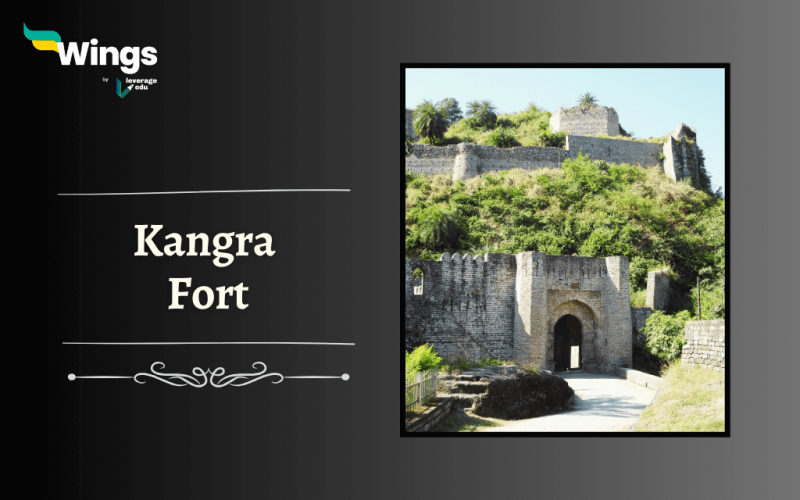Kangra Fort is also known as “Nagarkot” and “Kot Kangra”. The fort is located in the Kangra district of Himachal Pradesh. The fort is strategically nestled in the picturesque Kangra Valley. With its imposing walls and stunning views, this fort has witnessed countless battles, intrigues, and triumphs over the centuries. Let’s delve deep into the history and features of Kangra Fort to uncover its allure.
Table of Contents [show]
| Commissioned by | Bhuma Chand |
| Also Known as | Kot Kangra |
| Location | Kangra, Himachal Pradesh |
| Timings | 9:00 am to 5:30 pm; Open Everyday |
| Entry Fee for fort | For Indian citizens – Rs 150; For Foreigners – Rs 300 |
| Camera | Allowed and Free |
History of Kangra Fort
The origins of Kangra Fort can be traced back to ancient times, with the earliest mentions of the fort dating back to the Mahabharata epic.
- It was built by the Katoch dynasty (Rajputs) of the Kangra State and has origins in the Trigata Kingdom.
- Bhuma Chand was the founder of the Katoch Dynasty and is believed to have commissioned the building of the Kangra Fort.
- Earliest remains also show Jain and Brahminical temples (9th-10th century AD)
- The first recorded mention of the fort is of invasion by Mahmud Ghazni in 1009 AD. The fort was seized by Muhammad Bin Tughluq in 1337 AD.
Mughal Era:
- Raja Dharam Chand submitted to Mughal Emperor Akbar in 1556 after 52 failed attempts but later resisted Mughal control.
- But Mughal Emperor Jahangir captured the fort in 1620, killing the Katoch king Raja Hari Chand and annexing the Kangra kingdom.
- The fort remained under Mughal rule until 1783.
Post-Mughal Era:
- Raja Sansar Chand, the descendant of Dharam Chand, attempted to regain control with Sikh support.
- The fort changed hands several times between Sikh misls and Sansar Chand.
- In 1805, Sansar Chand faced the Gurkhas who threatened Kangra.
- Sansar Chand sought help from Maharaja Ranjit Singh, leading to the Nepal-Sikh War in 1809.
- The Gurkhas were defeated, and Ranjit Singh took control of the fort and surrounding villages on 24th Aug 1809.
British Rule and Later Years:
- The British captured the fort on 28 May 1846 after the First Anglo-Sikh War under Henry Lawrence.
- A British garrison occupied the fort until it was damaged in a 1905 earthquake.

Features of Kangra Fort
The architecture of Kangra Fort is a perfect blend of Rajput and Islamic styles, with intricate carvings and grand gateways.
- The entrance of the fort was built during the Sikh period through a small courtyard, which is enclosed between two gates.
- There are two doors dedicated to the Mughal Governor of Kangra, Nawab Saif Ali Khan. The names of them are – Ahani and Amir Darwaza.
- Another gate is built at a sharp angle named Jehangir Darwaza, Ranjit Darwaza and Andheri Darwaza.
- The Darsani Darwaza stands at the end with Lakshmi Narayan Temple and Sitlamata Temple.
- Other temples that exit inside the fort are – Ambika Devi Temple, Jain Temple of Lord Adinath and some other temples and pedestals that are in dilapidated conditions.
Also Read – Aguada Fort History: Features, Facts, Timings & More
Facts about Kangra Fort
Kangra Fort is considered to be one of the oldest and largest forts in India, spanning an area of approximately 4 square kilometres.
- The ASI gave back control of the fort to Maharaja Jai Chandra of the Katoch Dynasty.
- There are rumours of nearly 21 treasure wells, out of which Mahmud, Sultan and Ghazni looted the wells and some of them are not yet discovered.
- A mosque was built by Jehangir inside the fort. Even though due to the earthquake, the building is in ruins.
Also Read – Lohagad Fort History: Features, Facts, Timing & More
Timings of Kangra Fort
The timings for visiting the Monument and watching the mesmerising views are as –
| Purpose | Timings |
| Entry | 9:00 am to 5:30 pm |
| Week Entry | Everyday |
| Entry Fee | For Indian citizens- Rs 150; For Foreigners – Rs 300 |
| For Maharaja Sansar Chand Museum – Rs 5 (change applicable) | |
| Camera | Free |
Thus, the fort is an amalgamation of Temples, Mosques and Jain Temples. After the tragic event of the earthquake on 4th April 1905, the fort fell to ruins and weathered with time. The ancient history of the fort holds its name from the ancient story of Mahabharata and tells the story to date.

Other Attractions near Kangra Fort
| Bahgsunag Waterfalls | Gyuto Monastery |
| War Memorial | Chamunda Devi Temple |
| Bahgsunag Temple | Nechung Monastery |
| Jwala Devi Temple | Kareri Lake |
| Brajeshwari Temple | Indrahar Pass |
| Baijnath Temple | Taragarh Palace |
Relevant Blogs
That’s all about Kangra Fort history! If you want to know more about topics like this, then visit our general knowledge page! Alternatively, you can also read our blog on general knowledge for competitive exams!
 One app for all your study abroad needs
One app for all your study abroad needs















 45,000+ students trusted us with their dreams. Take the first step today!
45,000+ students trusted us with their dreams. Take the first step today!
